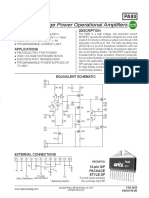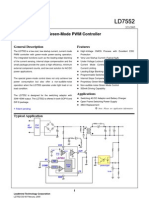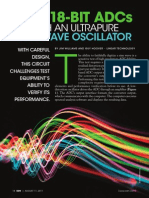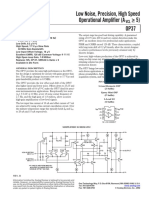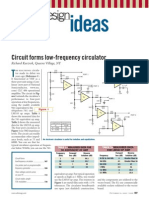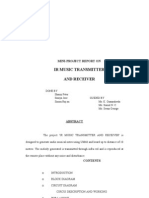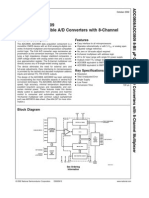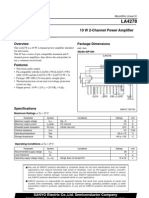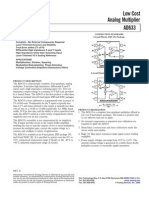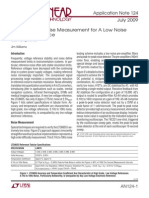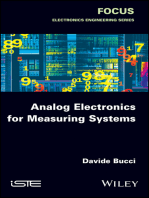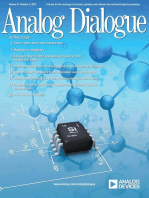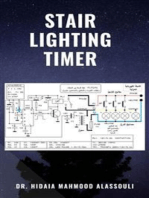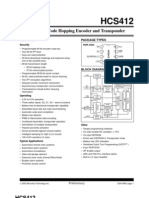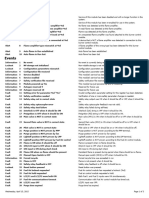CN0350
CN0350
Uploaded by
Narayan ApteCopyright:
Available Formats
CN0350
CN0350
Uploaded by
Narayan ApteCopyright
Available Formats
Share this document
Did you find this document useful?
Is this content inappropriate?
Copyright:
Available Formats
CN0350
CN0350
Uploaded by
Narayan ApteCopyright:
Available Formats
Circuit Note
CN-0350
Circuits from the Lab reference designs are engineered and
tested for quick and easy system integration to help solve todays
analog, mixed-signal, and RF design challenges. For more
information and/or support, visit www.analog.com/CN0350.
Devices Connected/Referenced
AD8608
Precision, Low Noise, Quad CMOS, Rail
to Rail Input/Output Op Amp
AD7091R 1 MSPS, Ultralow Power, 12-Bit ADC
12-Bit, 1 MSPS, Single-Supply, Two-Chip Data Acquisition System for
Piezoelectric Sensors
EVALUATION AND DESIGN SUPPORT
Circuit Evaluation Boards
CN0350 Circuit Evaluation Board (EVAL-CN0350-PMDZ)
SDP/PMD Interposer board (SDP-PMD-IB1Z)
System Demonstration Platform (EVAL-SDP-CB1Z)
Design and Integration Files
Schematics, Layout Files, Bill of Materials
CIRCUIT FUNCTION AND BENEFITS
The circuit shown in Figure 1 is a 12-bit, 1 MSPS data
acquisition system utilizing only two active devices.
The system processes charge input signals from piezoelectric
sensors using a single 3.3 V supply and has a total error of less
than 0.25% FSR after calibration over a 10C temperature
range, making it ideal for a wide variety of laboratory and
industrial measurements.
The small footprint of the circuit makes this combination an
industry-leading solution for data acquisition systems where
accuracy, speed, cost, and size play a critical role.
Figure 1. Charge Input Single Supply Data Acquisition System for Piezoelectric Sensors (All Connections and Decoupling Not Shown)
TP1
C
CAL
1nF
C2
1nF
C8
4.7nF
C9
1F
4
J1
3
2
1
TP2 TP3
R3
100M
R1
10k
R2
10k
R7
10k
R10
100
R6
51
R4
1k
R5
270
R8
DNP
TP4
2.5V
+3.3V
+3.3V
+3.3V
TP6
1.25V
U1B
1/4
AD8608
U1A
1/4
AD8608
U1D
1/4
AD8608
U1C
1/4
AD8608
U2
AD7091R
HREF
TP5
VIN
VREF
GND REGCAP
CS
SCLK
CONVST
SDATA
VDRIVE
V
DD
CAL
POS
NEG
INPUT CON
PIEZOELECTRIC SENSOR
GND
SS
SCK
+3.3V
J2
PMOD CON
12 PIN
CONV
MISO
GND
HREF
HREF
+3.3V
1
1
9
1
0
-
0
0
1
Rev. 0
CircuitsfromtheLabreferencedesignsfromAnalogDeviceshavebeendesignedandbuiltbyAnalog
Devices engineers. Standard engineering practices have been employed in the design and
constructionofeachcircuit,andtheirfunctionandperformancehavebeentestedandverifiedinalab
environment at roomtemperature. However, you are solely responsible for testing the circuit and
determiningitssuitabilityandapplicabilityforyouruseandapplication. Accordingly, innoeventshall
AnalogDevicesbeliablefordirect,indirect,special,incidental,consequentialorpunitivedamagesdue
toanycausewhatsoeverconnectedtotheuseofanyCircuitsfromtheLabcircuits. (Continuedonlastpage)
One Technology Way, P.O. Box 9106, Norwood, MA 02062-9106, U.S.A.
Tel: 781.329.4700 www.analog.com
Fax: 781.461.3113 2014 Analog Devices, Inc. All rights reserved.
CN-0350 Circuit Note
CIRCUIT DESCRIPTION
The circuit consists of an input signal conditioning stage and an
ADC stage. The current input signal is converted to voltage by
charge-to-voltage converter (charge amplifier of the U1A op amp
and capacitor C2) and amplified by a noninverting amplifier
(the U1D op amp and the R7 and R8 resistors). The buffered
and attenuated (the U1B and U1C op amps and the resistors R1
and R2) voltage reference (VREF =2.5 V) from the ADC is used
to generate an offset HREF of 1.25 V for conditioning the ac signal
from sensor to input range of the ADC. Op amps U1A, U1B,
U1C, and U1D are one quad AD8608. The output of the U1D
op amp is 0.1 V to 2.4 V which matches the input range of the
ADC (0 V to 2.5 V) with 100 mV headroom to maintain linearity.
Resistor and capacitor values can be modified to accommodate
other sensor ranges as described in this circuit note.
The circuit design allows single supply operation. The minimum
output voltage specification of the AD8608 is 50 mV for a 2.7 V
power supply and 290 mV for 5 V power supply with 10 mA
load current, over the temperature range of 40C to +125C. A
minimum output voltage of 45 mV to 60 mV is a conservative
estimate for a 3.3 V power supply, a load current less than 1 mA,
and a narrower temperature range.
Considering the tolerances of the parts, the minimum output
voltage (low limit of the range) is set to 100 mV to allow for a
safety margin. The upper limit of the output range is set to 2.4 V
in order to give 100 mV headroom for the positive swing at the
ADC input. Therefore, the nominal output voltage range of the
input op amp is 0.1 V to 2.4 V.
The AD8608 is chosen for this application because of its low
bias current (1 pA maximum), low noise (12 nV/Hz maximum)
and low offset voltage (65 V maximum). Power dissipation is
only 15.8 mW on a 3.3 V supply.
A single-pole RC filter (R6/C8) follows the op amp output stage
to reduce the out-of-band noise. The cutoff frequency of the RC
filter is set to 664 kHz.
The AD7091R 12-bit 1 MSPS SAR ADC is chosen because of its
ultra-low power 349 A at 3.3 V (1.2 mW) which is significantly
lower than any competitive ADC currently available in the market.
The AD7091R also contains an internal 2.5 V reference with
4.5 ppm/C typical drift. The input bandwidth is 7.5 MHz, and
the high speed serial interface is SPI compatible. The AD7091R
is available in a small footprint 10-lead MSOP.
The total power dissipation of the circuit is approximately
17 mW when operating on a 3.3 V supply.
The AD7091R requires a 50 MHz serial clock (SCLK) to achieve
a 1 MSPS sampling rate. In most piezoelectric sensor applications,
a lower sampling rate can be used. The test data taken in this
circuit note used an SCLK of 30 MHz and a sampling rate of
300 kSPS.
The digital SPI interface can be connected to the microprocessor
evaluation board using the 12-pin PMOD-compatible connector
(Digilent PMOD Specifications).
Circuit Design
The circuit shown in Figure 2 converts the input charge to voltage
and level shifts to the ADC input range of 0.1 V to 2.4 V.
Figure 2. Charge Input Signal Conditioning Circuit
Piezoelectric elements are commonly used for the measurement
of acceleration and vibration. Here, the piezoelectric crystal is
used in conjunction with a seismic mass m. If the mass is
subjected to an acceleration a, then there is a resulting inertial
force F = m a acting on the seismic mass and the piezoelectric
crystal. This results in the crystal acquiring a charge q = d F,
where d (measured in coulombs/newton, C/N) is the crystal
charge sensitivity to force.
The resulting steady-state charge sensitivity Sa of piezoelectric
accelerometer is Sa = q/a (measured in C s
2
/m).
Note that acceleration can be converted to g using the
relationship 1 g = 9.81 m/s
2
.
If the accelerometer is used with a charge amplifier with
feedback capacitance C2, as is shown in Figure 2, the voltage
developed across C2 due to a charge q is V = q/C2. The
corresponding steady state voltage sensitivity is:
SV= V/a = Sa/C2. Eq. 1
The first stage of the signal conditioning circuit in Figure 1 is a
charge amplifier (U1A and capacitor C2), where the output
voltage is changing corresponding to Equation 1. The output of
the circuit is shifted to handle bipolar input signals (for example,
vibration measurements). The zero of the circuit is shifted to
the middle of the input range of the ADC, using a reference of
1.25 V. The output voltage of the charge amplifier is:
a
C
S
V
C
q
V dt i
C
V V
a
HREF HREF N HREF O
2 2 2
1
1
+ = + = + =
Eq. 2
The second stage of the signal conditioning circuit in Figure 1 is
a non-inverting amplifier with an output voltage of:
a
C
S
R
R
V V
a
HREF O
|
.
|
\
|
+ + =
2 8
7
1
2
Eq. 3
C2
1nF
R3
100M
R7
10k
R8
DNP
R4
1k POS
NEG
R5
270
V
O1
V
O1
= a
C
S
i
IN
i
IN
=
+3.3V
U1A
1/4
AD8608
U1D
1/4
AD8608
V
O2
HREF
a
(ACCELERATION)
+1.25V
PIEZOELECTRIC
CRYSTAL
dq
dt
S
a
C2
1
1
9
1
0
-
0
0
2
Rev. 0 | Page 2 of 7
Circuit Note CN-0350
The resistor R3 (100 M to 10 G for ceramic sensors and
10 G to 10 T for crystal sensors) provides dc feedback for
the op amp and supplies the input bias current. This resistor
must be as small as possible for the minimum frequency
measured and determines the lowest limit of frequency input
range. At low frequency, the corner frequency fCL is
approximately
2 3 2
1
C R
f
CL
=
Eq. 4
Adding a resistor R4 (1 k to 10 k) in series with the op amp
inverting input improves stability and limits input currents due
to accidental high input voltage. Increasing R4 further leads to a
reduction in the high frequency response. At high frequency R4
may be comparable to the impedance ZS of the sensor (1/CS,
where CS is the capacitance of the piezoelectric sensor).
The high frequency corner frequency fCH is:
S
CH
C R
f
4 2
1
=
Eq. 5
Using Equation 1 to Equation 5, the parameters of the circuit
(C2, R7, R8, fCL, and fCH) can be calculated for a specific
application.
For example, the Kistler type 8002K quartz accelerometer has
the following specifications:
Range, 1000 g
Sensitivity, 1 pC/g
Capacitance, 90 pF typical
Frequency Response, 1%, +5% 0 Hz to 6000 Hz
Insulation Resistance, >10
13
For an output voltage swing at VO1 of 1 V, Equation 1 is used
to calculate C2.
C2 = Sa a /V = (1 pC/g 1000 g)/1 V =1 nF
For an ADC input voltage swing of 0.1 V to 2.4 V (1.25 V
1.15 V), the gain of noninverting amplifier has to be equal to
1.15, and the ratio R7/R8 = 0.15. Choose a standard value
resistor for R7 =10 k, then R8 = 66.67 k.
Choose R3 = 100 M and neglect the input resistance of the op
amp and insulation resistance of the piezoelectric sensor. The
corner frequency at low frequency is (see Equation 4)
Hz
C R
f
CL
6 . 1
10 10 2
1
2 3 2
1
9 8
=
= =
Choosing R4 =1 k, the corner frequency at high frequency is
(see Equation 5)
MHz
C R
f
S
CH
77 . 1
10 90 10 2
1
4 2
1
12 3
=
= =
Thus, the protecting resistor R4 = 1 k does not affect the high
pass frequency response because the upper frequency response
of the sensor is only 6 kHz.
Gain and Offset Error due to Tolerances of Resistors and
Reference Voltage
From Equation 3, the gain of the signal conditioning circuit is
2
1
8
7
1
C R
R
GAIN
|
.
|
\
|
+ =
Eq. 6
The relative gain error is,
G
GAIN
dGAIN
=
Using the logarithmic derivative principle,
2 ln 8 ln ) 7 8 ln( ln C R R R GAIN + =
Taking the derivative of lnGAIN,
2
2
8
8
8 7
7
8 7
8
C
dC
R
dR
R R
dR
R R
dR
GAIN
dGAIN
+
+
+
=
2
2
8
8
8 7
7
7
7
8 7
8
8
8
C
dC
R
dR
R R
R
R
dR
R R
R
R
dR
GAIN
dGAIN
+
+
+
=
2 8 7 8
8 7
7
8 7
8
C R R R G
R R
R
R R
R
+
+
+
=
2 7 8
8 7
7
1
8 7
8
C R R G
R R
R
R R
R
+
+
|
.
|
\
|
+
=
2 7 8
8 7
7
8 7
7
C R R G
R R
R
R R
R
+
+
|
.
|
\
|
+
=
( )
2 8 7
8 7
7
C R R G
R R
R
|
.
|
\
|
+
=
Eq. 7
Using 1% tolerance devices R7, R8 and C2, the summing gain
error can be estimated.
Worst case relative gain error:
% 26 . 1 %) 1 % 2 13 . 0 ( % 1 % 2
7 . 66 10
10
) (
8 7
7
) (
2 8 7 max
= + =
|
.
|
\
|
+
+
=
=
(
+ +
+
=
k k
k
R R
R
C R R G
Mean square error (root-sum-square error):
% 0168 . 1 % 1 % 1 13 . 0 2
) (
8 7
7
) (
2 2 2
2
2
2
8
2
7
2
= + =
+ +
|
.
|
\
|
+
=
C R R MSqE G
R R
R
From Equation 3, the output offset of the signal conditioning
circuit is
REF
V
R R
R
HREF OFFSET
2 1
2
+
= =
Eq. 8
and the relative offset error is
VREF R R OS
R R
R
+
= ) (
2 1
1
1 2
Eq. 9
For 1% tolerance of R1, R2, and VREF, the summing offset error
can be estimated.
Rev. 0 | Page 3 of 7
CN-0350 Circuit Note
Worst case relative offset error:
% 2 ) (
2 1
1
) (
1 2 max
=
(
+ +
+
=
VREF R R OS
R R
R
Mean square offset error (root-sum-square error):
% 225 . 1 % 1 % 1 5 . 0 2 ) (
2 2 2
= + =
MSqE OS
The errors, caused by the tolerances of the resistors, the offsets
of the AD8608 op amps (75 V), and the ADC AD7091R, are
eliminated after calibration procedure. It is still necessary to
calculate and verify that the U1D op amp output is within the
required range (0.1 V to 2.4 V).
Gain and Offset Error due to Temperature Drift of
Resistors and Voltage Reference
Using Equation 7 and Equation 9, the errors due to the temper-
ature drift of components can be calculated. For example, for
100 ppm/C temperature drift of resistors and for 25 ppm/C
drift for reference voltage the worst case gain error is less than
0.013%/C, and the worst case offset error is about 0.01%/C,
which corresponds to a worst case total error of less than 0.25%
for 10C temperature changes.
Effect of Active Component Temperature Coefficients on
Overall Error
The dc offsets of the AD8608 op amps (75 V) and the
AD7091R ADC are eliminated by the calibration procedure.
The offset drift of the AD7091R internal reference is
4.5 ppm/C typical and 25 ppm/C maximum.
The offset drift of the AD8608 op amp is 1.5 V/C typical and
6 V/C maximum.
Note that resistor drift is the largest contributor to total drift if
100 ppm/C resistors are used, and the drift due to active
components can be neglected.
Calibration and Test
Test the sensitivity of a charge amplifier before interfacing it with
the sensor so that the gain in the system can be calibrated. An
electronic calibration system that does not require application
of any mechanical load (acceleration, force, pressure, etc.) is
shown in Figure 3. An adjustable amplitude and frequency low
impedance output voltage source in series with the calibration
capacitor CCAL drives the charge input. The output of the voltage
source must be floating with respect to the circuit board ground
so that it can operate at the HREF common-mode voltage of 1.25 V.
Figure 3. Calibrated Charge Input Signal Conditioning Circuit
The amount of input charge is Q = CCAL VIN. For example, an
input sine wave voltage with 1 V amplitude and a 1 nF calibration
capacitor produces a peak charge input of 1000 pC. This can
be used to calibrate the system. It is important that a 1% tolerance
or better capacitor is selected for CCAL to minimize errors. Note
that the tolerance of CCAL affects the calibration accuracy. The
tolerance of C2 is responsible for the output range, however the
temperature change of C2 affects accuracy.
The circuit can then be checked and adjusted using an external
simulation capacitor CSIM. Another way to check the circuit is to
use the CAL input and an adjustable voltage source. For calibration
and simulation purposes, the capacitor CCAL can be changed by
connecting an external parallel capacitor with the appropriate
value and accuracy across TP1 and TP2. For other input ranges
the capacitor C2 can be changed by connecting an external
parallel capacitor with appropriate value and accuracy across
TP3 and TP4.
Figure 4 shows the measured ADC output for a 1V 1 kHz sine
wave input and CSIM = 1 nF. The charge input is therefore
1000 pC.
Figure 4. ADC Output for 1000 pC Input Charge, 1 kHz Sine Wave
H
REF
= 1.25V
V
IN
= 1V PEAK
1kHz SINE WAVE
C
CAL
C
SIM
CN-0350 BOARD
CAL
C2
INTERPOSER
BOARD
POS
CAL
SIM
NEG
1
1
9
1
0
-
0
0
3
1
1
9
1
0
-
0
0
4
Rev. 0 | Page 4 of 7
Circuit Note CN-0350
Figure 5 shows the actual output using a Loudity LD-BZPN-2312
Piezoelectric Sensor with excitation from a loudspeaker with
about 120 Hz sine wave vibrations. The circuit was calibrated with
a peak input sine wave voltage of 1 V and CCAL = C2 = 10 nF.
Figure 5. Measured Output of LD-BZPN-2312 Piezoelectric Sensor with
Excitation from Loudspeaker with 120 Hz Sine Wave Vibrations
Printed Circuit Board (PCB) Layout Considerations
In any circuit where accuracy is crucial, it is important to consider
the power supply and ground return layout on the board. The
PCB must isolate the digital and analog sections as much as
possible. The PCB for this system was constructed in a simple
2-layer stack up, but a 4-layer stack up will give better EMS. See
the MT-031 Tutorial for more discussion on layout and grounding
and the MT-101 Tutorial for information on decoupling tech-
niques. The power supply to AD8608 must be decoupled with
10 F and 0.1 F capacitors to properly suppress noise and reduce
ripple. The capacitors must be placed as close to the device as
possible with the 0.1 F capacitor having a low ESR value. Ceramic
capacitors are advised for all high frequency decoupling. Power
supply lines must have as large trace width as possible to provide
low impedance path and reduce glitch effects on the supply line.
High impedance circuits for conditioning piezoelectric sensor
output require attention to resistors, insulation (dielectrics), and
cabling. The low impedance input circuit of the charge amplifier
significantly reduce the cabling problems, but the requirements
on the resistors, insulators, and layout of electrometer amplifiers
can also be applied to charge amplifiers built from discrete com-
ponents. A guard ring around the sensitive input terminals on
both sides of printed circuit boards is recommended to
minimize input leakage currents . The guard encircles the
positive terminal and connects to the reference (common)
voltage HREF.
A complete documentation package including schematics,
board layout, and bill of materials (BOM) can be found at
www.analog.com/CN0350-DesignSupport.
COMMON VARIATIONS
The circuit is proven to work with good stability and accuracy
with the component values shown. Other precision op-amps
and other ADCs can be used in this configuration to convert
1000 pC input charge range to digital output and for other
various applications for this circuit.
The circuit in Figure 1 can be designed for other than 1000 pC
input charge ranges, following the equations given in the Circuit
Design section. The connectors TP3 and TP4 can be used to put
additional capacitance in parallel to C2 to build circuits for other
ranges. The connectors TP1 and TP2 can be used to put additional
capacitance in parallel to CCAL to calibrate the circuit for other
ranges.
The AD7091 is similar to the AD7091R, but without the voltage
reference output, and the input range is equal to the power supply
voltage. The AD7091 can be used with an ADR3425 2.5 V refer-
ence. The ADR3425 does not require buffering, therefore a
single AD8605 and dual AD8606 can be used in the circuit.
The ADR3425 is a precision 2.5 V band gap voltage reference,
featuring low power and high precision (8 ppm/C of temperature
drift) in a 6-lead SOT-23 package.
The AD8601, AD8602 and AD8604 are single, dual, and quad
rail-to-rail, input and output, single-supply amplifiers featuring
very low offset voltage and wide signal bandwidth, that can be
used in place of AD8605, AD8606, and AD8608.
The AD7457 is a 12-bit, 100 kSPS, low power, SAR ADC, and can
be used in combination with the ADR3425 voltage reference in
place of AD7091R, when a higher throughput rate is not needed.
CIRCUIT EVALUATION AND TEST
This circuit uses the EVAL-CN0350-PMDZ circuit board, the
SDP-PMD-IB1Z and the EVAL-SDP-CB1Z system demonstration
platform (SDP) evaluation board. The interposer board SDP-
PMD-IB1Z and the SDP board EVAL-SDP-CB1Z have 120-pin
mating connectors. The interposer board and the EVAL-CN0350-
PMDZ board have 12-pin PMOD matching connectors, allowing
quick setup and evaluation of the performance of the circuit.
The EVAL-CN0350-PMDZ board contains the circuit to be
evaluated, as described in this note and the SDP evaluation
board is used with the CN0350 evaluation software to capture
the data from the EVAL-CN0350-PMDZ circuit board.
Equipment Needed
PC with a USB port, Windows XP or Windows Vista (32-
bit), or Windows 7/8 (64-bit or 32-bit)
EVAL-CN0350-PMDZ circuit evaluation board
EVAL-SDP-CB1Z SDP evaluation board
SDP-PMD-IB1Z interposer board
EVAL-CFTL-6V-PWRZ power supply
CN0350 evaluation software
Precision voltage generator
1
1
9
1
0
-
0
0
5
Rev. 0 | Page 5 of 7
CN-0350 Circuit Note
Getting Started
Load the evaluation software by placing the CN0350 evaluation
software disc in the CD drive of the PC. You also can download
the most up to date copy of the evaluation software from
CN0350 evaluation software. Using My Computer, locate the
drive that contains the evaluation software disc and open the
file setup.exe. Follow the on-screen prompts to finish the
installation. It is recommended to install all software
components to the default locations.
Functional Block Diagram
Figure 6 shows the functional diagram of the test setup.
Setup
Connect the EVAL-CFTL-6V-PWRZ (+6 V dc power
supply) to SDP-PMD-IB1Z interposer board via the dc
barrel jack
Connect the SDP-PMD-IB1Z (interposer board) to the
EVAL-SDP-CB1Z SDP board via the 120-pin ConA
connector
Connect the EVAL-SDP-CB1Z (SDP board) to the PC via
the USB cable
Connect the EVAL-CN0350-PMDZ evaluation board to
the SDP-PMD-IB1Z interposer board via the 12-pin
header PMOD connector
Connect the voltage generator to the EVAL-CN0350-
PMDZ evaluation board via terminal block J1Test
Launch the evaluation software. The software is able to communi-
cate to the SDP board if the Analog Devices system development
platform drivers are listed in the device manager. Once USB
communications are established, the SDP board can be used to
send, receive, and capture serial data from the EVAL-CN0350-
PMDZ board. Data can be saved in the computer for various
values of input voltages. Information and details regarding how
to use the evaluation software for data capturing can be found at
CN0350 Software User Guide.
A photo of the EVAL-CN0350-PMDZ board is shown in Figure 7.
Figure 6. Functional Diagram of Test Setup
Figure 7. Photo of EVAL-CN0350-PMDZ Board
J2
PMOD
J3
PMOD
EVAL-CFTL-6V-PWRZ
6V WALL WART
PC
EVAL-SDP-CB1Z
SDP-B BOARD
SDP-PMD-IB1Z
INTERPOSER BOARD
USB
CON A
J1
J4
120 PINS EVAL-CN0350-PMDZ
J1
VOLTAGE
GENERATOR/
PIEZOELECTRIC
SENSOR
1
1
9
1
0
-
0
0
6
1
1
9
1
0
-
0
0
7
Rev. 0 | Page 6 of 7
Circuit Note CN-0350
LEARN MORE
CN0350 Design Support Package:
http://www.analog.com/CN0350-DesignSupport
Pallas-Areny, Ramon and John G. Webster. Sensors and Signal
Conditioning. Copyright 2001, John Wiley & Sons.
MT-031 Tutorial, Grounding Data Converters and Solving the
Mystery of "AGND" and "DGND." Analog Devices.
MT-101 Tutorial, Decoupling Techniques. Analog Devices.
MT-004 Tutorial, The Good, the Bad, and the Ugly Aspects of
ADC Input NoiseIs No Noise Good Noise?. Analog Devices.
Data Sheets and Evaluation Boards
AD8608 Data Sheet
AD7091R Data Sheet
REVISION HISTORY
5/14Revision 0: Initial Version
(Continued from first page) Circuits from the Lab reference designs are intended only for use with Analog Devices products and are the intellectual property of Analog Devices or its licensors.
While you may use the Circuits from the Lab reference designs in the design of your product, no other license is granted by implication or otherwise under any patents or other intellectual
property by application or use of the Circuits from the Lab reference designs. Information furnished by Analog Devices is believed to be accurate and reliable. However, Circuits from the
Lab reference designs are supplied "as is" and without warranties of any kind, express, implied, or statutory including, but not limited to, any implied warranty of merchantability,
noninfringement or fitness for a particular purpose and no responsibility is assumed by Analog Devices for their use, nor for any infringements of patents or other rights of third parties
that may result from their use. Analog Devices reserves the right to change any Circuits from the Lab reference designs at any time without notice but is under no obligation to do so.
2014 Analog Devices, Inc. All rights reserved. Trademarks and
registered trademarks are the property of their respective owners.
CN11910-0-5/14(0)
Rev. 0 | Page 7 of 7
You might also like
- 8 Bit Password Security System PDFDocument9 pages8 Bit Password Security System PDFM AzeemNo ratings yet
- 15 To 60 Watt Audio Amplifiers Using Complementary Darlington Output Transistors - An-483BDocument8 pages15 To 60 Watt Audio Amplifiers Using Complementary Darlington Output Transistors - An-483BAnonymous kdqf49qb100% (1)
- Step Recovery Diode Frequency MultiplierDocument4 pagesStep Recovery Diode Frequency MultiplierfahkingmoronNo ratings yet
- PA System Design Fundamentals (Book 1) PDFDocument122 pagesPA System Design Fundamentals (Book 1) PDFSimon Condor40% (5)
- High Accuracy Impedance Measurements Using 12-Bit Impedance ConvertersDocument6 pagesHigh Accuracy Impedance Measurements Using 12-Bit Impedance Converterschristobal_huntaNo ratings yet
- CN0217Document6 pagesCN0217alraca1234No ratings yet
- STK400 040Document10 pagesSTK400 040Carlos Milton Martinez GaleanoNo ratings yet
- DiDocument5 pagesDiTao Quang BinhNo ratings yet
- AN-1141 Application Note: Powering A Dual Supply Precision ADC With Switching RegulatorsDocument8 pagesAN-1141 Application Note: Powering A Dual Supply Precision ADC With Switching RegulatorsVINITA AGARWALNo ratings yet
- 7SS522 CT RequirementDocument4 pages7SS522 CT RequirementAnonymous 9EV0OmkNo ratings yet
- Class D Amplifier With Maximum Power Adjustable From 20W To 300WDocument13 pagesClass D Amplifier With Maximum Power Adjustable From 20W To 300Wramontv032428No ratings yet
- Class D Amplifier With Maximum Power Adjustable From 20W To 300WDocument13 pagesClass D Amplifier With Maximum Power Adjustable From 20W To 300Wramontv032428100% (1)
- CN0376Document7 pagesCN0376Milan ĐorđevicNo ratings yet
- DeDocument7 pagesDeSudhakar SpartanNo ratings yet
- 06616415Document5 pages06616415jitu_4No ratings yet
- Use A Transistor As A Heater PDFDocument5 pagesUse A Transistor As A Heater PDFFlorin Marica100% (1)
- SG3524 SMPS Control Circuit: Description Pin ConfigurationDocument5 pagesSG3524 SMPS Control Circuit: Description Pin ConfigurationNiko OlnicasaNo ratings yet
- STK4132IIDocument8 pagesSTK4132IIAttila SzelelkiNo ratings yet
- High Voltage Power Operational Amplifiers: Features DescriptionDocument6 pagesHigh Voltage Power Operational Amplifiers: Features DescriptionWaqas Ayub100% (1)
- LM1812 Ultrasonic Transceiver: General DescriptionDocument10 pagesLM1812 Ultrasonic Transceiver: General DescriptionYogesh RamdasiNo ratings yet
- Auto Shut OffDocument5 pagesAuto Shut OffJuan Manuel Han MacNo ratings yet
- ACS712 DatasheetDocument15 pagesACS712 DatasheetHernan PorriniNo ratings yet
- Iso 122Document18 pagesIso 122rnjlmv83100% (1)
- DiDocument6 pagesDipani256No ratings yet
- Green-Mode PWM Controller: General Description FeaturesDocument10 pagesGreen-Mode PWM Controller: General Description FeaturesLuis Luis GarciaNo ratings yet
- LA4278Document7 pagesLA4278aalex28No ratings yet
- Ring OscillatorDocument12 pagesRing OscillatorCmeLiv InmyHart NpaynoRentNo ratings yet
- MC1648 DataSheetDocument11 pagesMC1648 DataSheetKWojtek100% (1)
- 7107 VoltmeterDocument5 pages7107 VoltmeterAmir EsmaeeliNo ratings yet
- Forward Design 300W STmicroelectronics App NoteDocument10 pagesForward Design 300W STmicroelectronics App Notecristi7521No ratings yet
- 9-0-9 Step Down TransformerDocument20 pages9-0-9 Step Down TransformerSarthak JoshiNo ratings yet
- LD7552 DS 00Document10 pagesLD7552 DS 00BRIGHT_SPARKNo ratings yet
- FinalDocument16 pagesFinalgax4bab100% (1)
- 26070-Test 18 Bit ADCs With An Ultrapure Sine Wave Oscillator PDFDocument5 pages26070-Test 18 Bit ADCs With An Ultrapure Sine Wave Oscillator PDFLuca CarboneNo ratings yet
- OP37Document16 pagesOP37Josef StevanusNo ratings yet
- AFT05MP075NDocument21 pagesAFT05MP075NjeremyAW2SNo ratings yet
- Analog Devices Circuit NoteDocument7 pagesAnalog Devices Circuit Notevighnesh shanbhagNo ratings yet
- Simple FSKDocument6 pagesSimple FSKFaten AliNo ratings yet
- Ir Music TransmitterDocument20 pagesIr Music TransmitterYedla Avinash Lucky's0% (1)
- ADC0809CCNDocument16 pagesADC0809CCNFrancesca Castelar BenalcazarNo ratings yet
- Ulta Stepup DC To DC Conveter With Reduced Switch StressDocument21 pagesUlta Stepup DC To DC Conveter With Reduced Switch StressDRISHYANo ratings yet
- MCP 3201Document28 pagesMCP 3201Nacer MezghicheNo ratings yet
- La 4278Document6 pagesLa 4278Carlos López Rivera0% (1)
- CN0216Document5 pagesCN0216Ram VillaNo ratings yet
- AN1318Document10 pagesAN1318iarangoNo ratings yet
- TV Modulator Circuit: Semiconductor Technical DataDocument10 pagesTV Modulator Circuit: Semiconductor Technical Databanduat83No ratings yet
- Features Description: D D D D D D D D D D D DDocument16 pagesFeatures Description: D D D D D D D D D D D D1eugen1No ratings yet
- S T K 4 2 3 1 I I 2-Channel Loowmin Af Power Amp (Dual Supplies)Document8 pagesS T K 4 2 3 1 I I 2-Channel Loowmin Af Power Amp (Dual Supplies)Arthur JonesNo ratings yet
- Low Cost Analog Multiplier: AD633JN/AD633ANDocument8 pagesLow Cost Analog Multiplier: AD633JN/AD633ANNarendra BholeNo ratings yet
- An Analog Current Controller Design For Laser Diodes: Todd P. MeyrathDocument7 pagesAn Analog Current Controller Design For Laser Diodes: Todd P. MeyrathAfzal345No ratings yet
- 4 X 25W Quad Bridge Car Radio Amplifier: DescriptionDocument11 pages4 X 25W Quad Bridge Car Radio Amplifier: DescriptionJose Juan Cuevas DiazNo ratings yet
- Low Noise An124fDocument12 pagesLow Noise An124fraulqrvNo ratings yet
- Reference Guide To Useful Electronic Circuits And Circuit Design Techniques - Part 2From EverandReference Guide To Useful Electronic Circuits And Circuit Design Techniques - Part 2No ratings yet
- Reference Guide To Useful Electronic Circuits And Circuit Design Techniques - Part 1From EverandReference Guide To Useful Electronic Circuits And Circuit Design Techniques - Part 1Rating: 2.5 out of 5 stars2.5/5 (3)
- Analog Dialogue, Volume 48, Number 1: Analog Dialogue, #13From EverandAnalog Dialogue, Volume 48, Number 1: Analog Dialogue, #13Rating: 4 out of 5 stars4/5 (1)
- Premia Panel LightsDocument2 pagesPremia Panel LightsNarayan ApteNo ratings yet
- Ultra Fast Switches - Basic Elements For Future Medium Voltage SwitchgearDocument7 pagesUltra Fast Switches - Basic Elements For Future Medium Voltage SwitchgearNarayan ApteNo ratings yet
- Tel: (592) 252-9530 (P. R. China) Email:: 2.6 5.5V Avdd DVDD Refp 0.1u Vout R3Document1 pageTel: (592) 252-9530 (P. R. China) Email:: 2.6 5.5V Avdd DVDD Refp 0.1u Vout R3Narayan ApteNo ratings yet
- Biasing Internally Amplified Accelerometers: Bias RequirementsDocument4 pagesBiasing Internally Amplified Accelerometers: Bias RequirementsNarayan ApteNo ratings yet
- Dear Customer: For Best Recharge Options Always!Document1 pageDear Customer: For Best Recharge Options Always!Narayan ApteNo ratings yet
- Development of A Low Cost Touch Trigger Probe For CNC LathesDocument7 pagesDevelopment of A Low Cost Touch Trigger Probe For CNC LathesNarayan ApteNo ratings yet
- HNM BookDocument268 pagesHNM BookasnsashankNo ratings yet
- 5.5" PmoledDocument4 pages5.5" PmoledNarayan ApteNo ratings yet
- SSVC6 ManualDocument6 pagesSSVC6 ManualPaulo FoglianoNo ratings yet
- XL 2020 ManualDocument44 pagesXL 2020 ManualSoma GhoshNo ratings yet
- Electrical DictionaryDocument91 pagesElectrical DictionaryQudratullah EhsanNo ratings yet
- Alfa147 Key Chip DatasheetDocument44 pagesAlfa147 Key Chip DatasheetEef MaertenNo ratings yet
- Bk-Precision 1472c 1477 10mv 15mhz Oscilloscope Full SMDocument44 pagesBk-Precision 1472c 1477 10mv 15mhz Oscilloscope Full SMpasantito100% (1)
- Chapter3 Bipolar Junction Transistor PDFDocument28 pagesChapter3 Bipolar Junction Transistor PDFJ VikasNo ratings yet
- Tda 7296Document15 pagesTda 7296Attila ÉrchegyiNo ratings yet
- BCA AdvancedDocument43 pagesBCA AdvancedManasvi MehtaNo ratings yet
- M.E. MechatronicsDocument59 pagesM.E. MechatronicsSadursh DarshanNo ratings yet
- RFPA - Tetrode and Pentode RF Power Amplifier Information (By Larry E. Gugle K4RFE)Document4 pagesRFPA - Tetrode and Pentode RF Power Amplifier Information (By Larry E. Gugle K4RFE)apostolos2691No ratings yet
- Drts 66 Drts 66: Automatic Relay Test SystemDocument8 pagesDrts 66 Drts 66: Automatic Relay Test SystemIrvin Jürgen Ospina EspinozaNo ratings yet
- Tps 40100Document41 pagesTps 40100AnjuNo ratings yet
- Network Brochure Feb-08 PDFDocument46 pagesNetwork Brochure Feb-08 PDFassis_campos8950No ratings yet
- Philips Chassis 3a Circuit DescriptionDocument90 pagesPhilips Chassis 3a Circuit DescriptionBert HeerenNo ratings yet
- AlertsEvents BC 150415Document3 pagesAlertsEvents BC 150415Pablo SánchezNo ratings yet
- Philips RF Manual 4th EditionDocument35 pagesPhilips RF Manual 4th EditionsankprasadNo ratings yet
- Differentiator ExperimentDocument25 pagesDifferentiator ExperimentAlyaa Nadzirah Binti Shbini100% (1)
- Design_project1Document4 pagesDesign_project1GuoJiachun2023No ratings yet
- 96 CB Projects PenfoldDocument96 pages96 CB Projects PenfoldleftNo ratings yet
- Amplificador de Flama Honeywell R7849Document8 pagesAmplificador de Flama Honeywell R7849Tun Tun KleemannNo ratings yet
- Tda 2003Document9 pagesTda 2003Nadin Villarroel TrollanoNo ratings yet
- Tl1451a PDFDocument36 pagesTl1451a PDFmat70matNo ratings yet
- Practical Electronics 1968 04Document84 pagesPractical Electronics 1968 04Carlos Soares100% (3)
- Pioneer @kannur 9061223242 @calicut 9995044754 @thrissur 9846500207 @palakkad 7034223242 @cochin 9961758262 @kottayam 9207346045Document16 pagesPioneer @kannur 9061223242 @calicut 9995044754 @thrissur 9846500207 @palakkad 7034223242 @cochin 9961758262 @kottayam 9207346045Anandhu cNo ratings yet
- Features: TL494 Pulse-Width-Modulation Control CircuitsDocument19 pagesFeatures: TL494 Pulse-Width-Modulation Control CircuitsEdgarAlonsoNo ratings yet
- Public Address & General Alarm System: Configuration & Installation ManualDocument54 pagesPublic Address & General Alarm System: Configuration & Installation Manualmuzammil shadabNo ratings yet
- 60W MosFet Audio AmplifierDocument4 pages60W MosFet Audio AmplifierRyn YahuFNo ratings yet
- Singhania University: B.Tech - Aeronautical Engineering (Avionics) SyllabusDocument35 pagesSinghania University: B.Tech - Aeronautical Engineering (Avionics) SyllabusOmkar GiridharNo ratings yet


















